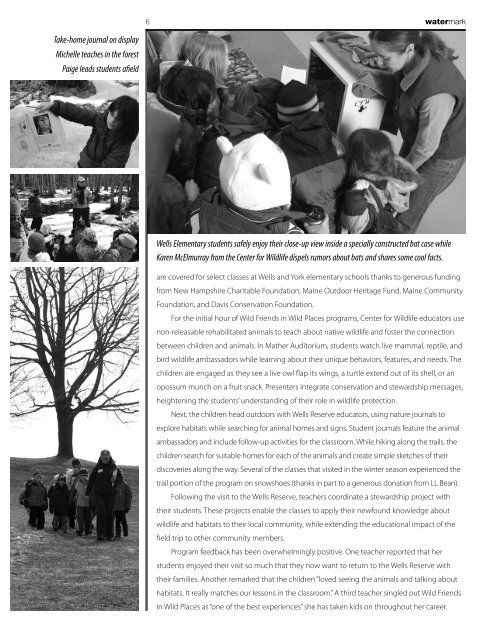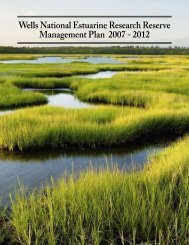inside - Wells National Estuarine Research Reserve
inside - Wells National Estuarine Research Reserve
inside - Wells National Estuarine Research Reserve
Create successful ePaper yourself
Turn your PDF publications into a flip-book with our unique Google optimized e-Paper software.
Take-home journal on display<br />
Michelle teaches in the forest<br />
Paige leads students afield<br />
6<br />
watermark<br />
<strong>Wells</strong> Elementary students safely enjoy their close-up view <strong>inside</strong> a specially constructed bat case while<br />
Karen McElmurray from the Center for Wildlife dispels rumors about bats and shares some cool facts.<br />
are covered for select classes at <strong>Wells</strong> and York elementary schools thanks to generous funding<br />
from New Hampshire Charitable Foundation, Maine Outdoor Heritage Fund, Maine Community<br />
Foundation, and Davis Conservation Foundation.<br />
For the initial hour of Wild Friends in Wild Places programs, Center for Wildlife educators use<br />
non-releasable rehabilitated animals to teach about native wildlife and foster the connection<br />
between children and animals. In Mather Auditorium, students watch live mammal, reptile, and<br />
bird wildlife ambassadors while learning about their unique behaviors, features, and needs. The<br />
children are engaged as they see a live owl flap its wings, a turtle extend out of its shell, or an<br />
opossum munch on a fruit snack. Presenters integrate conservation and stewardship messages,<br />
heightening the students’ understanding of their role in wildlife protection.<br />
Next, the children head outdoors with <strong>Wells</strong> <strong>Reserve</strong> educators, using nature journals to<br />
explore habitats while searching for animal homes and signs. Student journals feature the animal<br />
ambassadors and include follow-up activities for the classroom. While hiking along the trails, the<br />
children search for suitable homes for each of the animals and create simple sketches of their<br />
discoveries along the way. Several of the classes that visited in the winter season experienced the<br />
trail portion of the program on snowshoes (thanks in part to a generous donation from LL Bean).<br />
Following the visit to the <strong>Wells</strong> <strong>Reserve</strong>, teachers coordinate a stewardship project with<br />
their students. These projects enable the classes to apply their newfound knowledge about<br />
wildlife and habitats to their local community, while extending the educational impact of the<br />
field trip to other community members.<br />
Program feedback has been overwhelmingly positive. One teacher reported that her<br />
students enjoyed their visit so much that they now want to return to the <strong>Wells</strong> <strong>Reserve</strong> with<br />
their families. Another remarked that the children “loved seeing the animals and talking about<br />
habitats. It really matches our lessons in the classroom.” A third teacher singled out Wild Friends<br />
in Wild Places as “one of the best experiences” she has taken kids on throughout her career.




